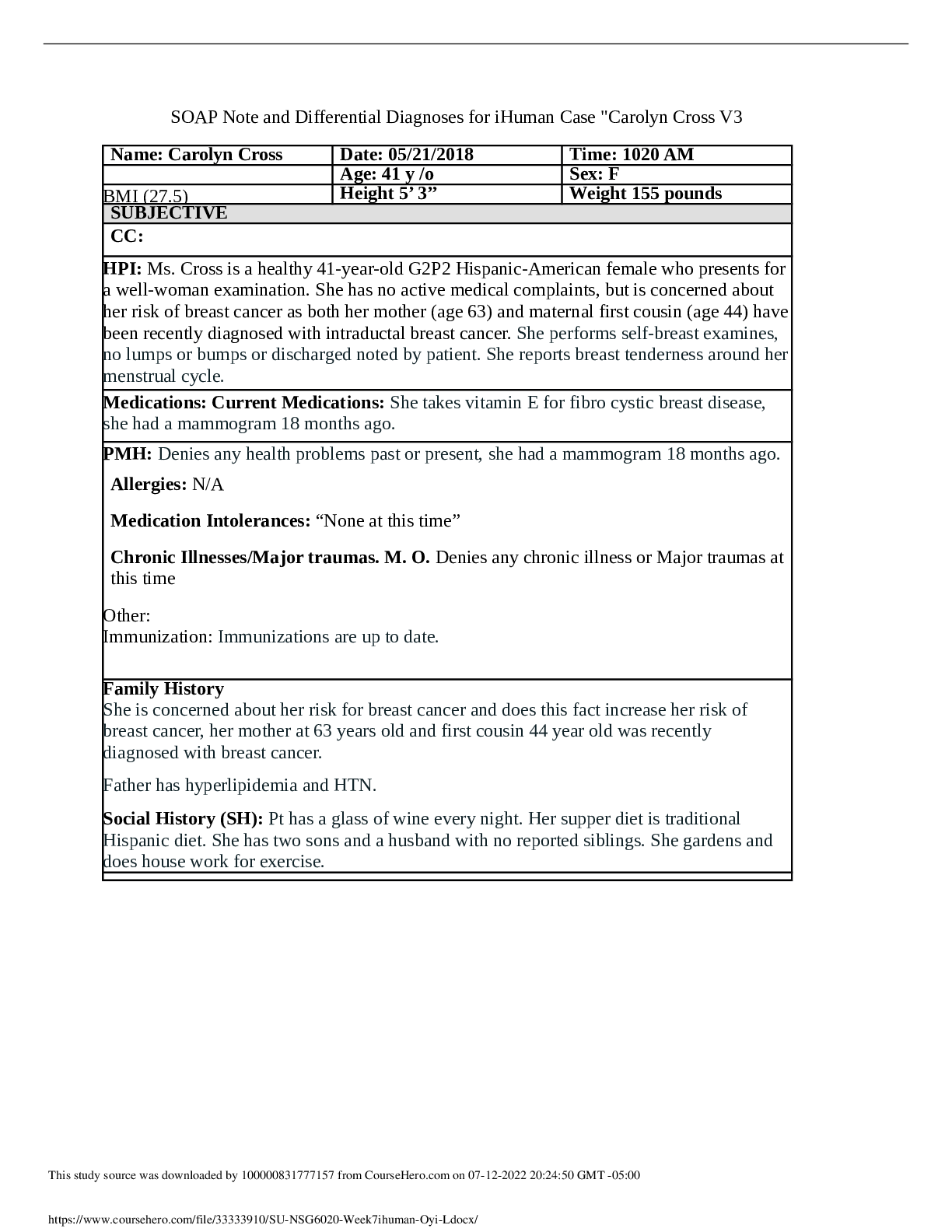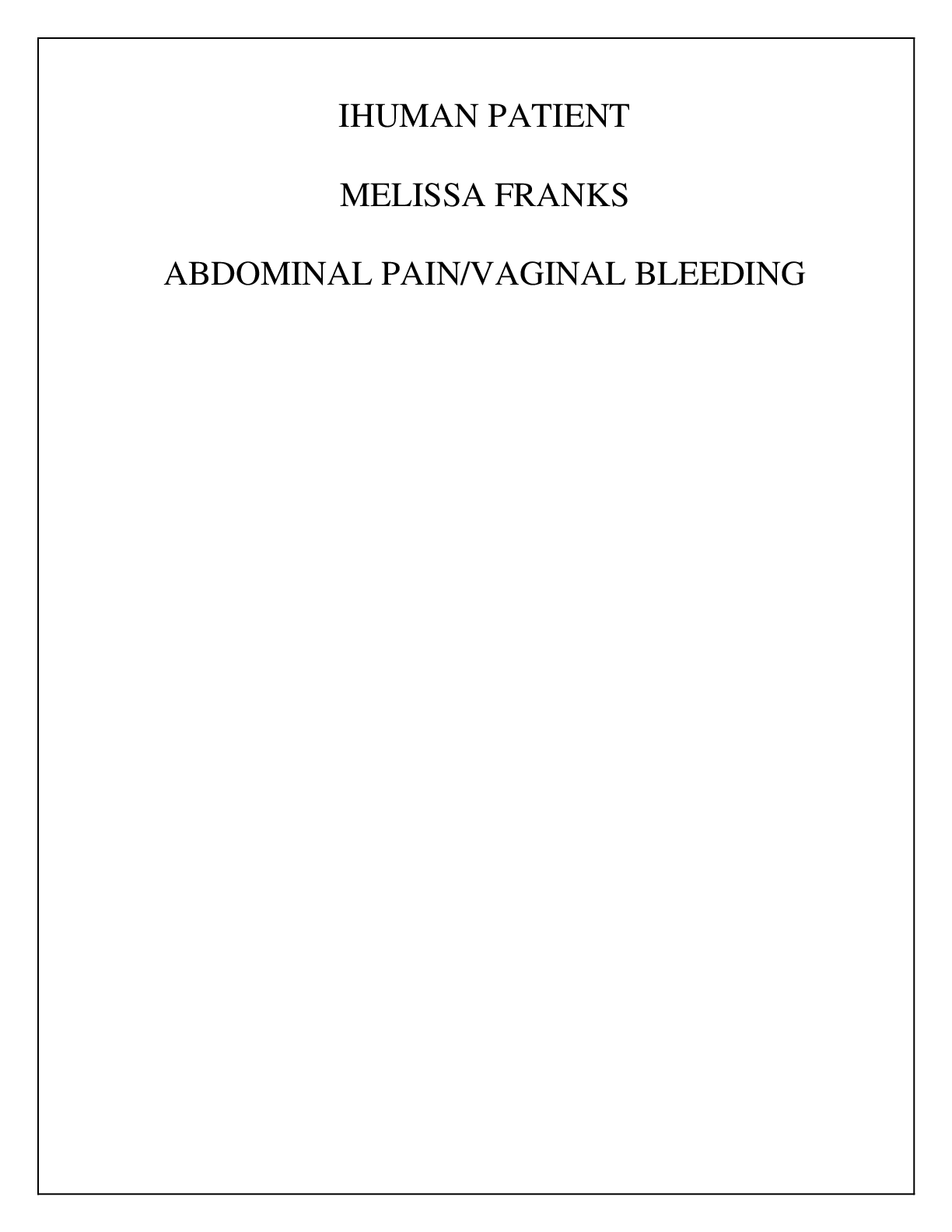NUR 3047 Sepsis/Septic Shock UNFOLDING Reasoning Case Study,100% CORRECT
Document Content and Description Below
NUR 3047 Sepsis/Septic Shock UNFOLDING Reasoning Case Study STUDENT Jack Holmes, 72 years old Primary Concept Perfusion Interrelated Concepts (In order of emphasis) • Inflammation �... �� Infection • Tissue Integrity • Clinical Judgment • Patient Education • Communication NCLEX Client Need Categories Percentage of Items from Each Category/Subcategory Covered in Case Study Safe and Effective Care Environment ✓ Management of Care 17-23% ✓ ✓ Safety and Infection Control 9-15% Health Promotion and Maintenance 6-12% ✓ Psychosocial Integrity 6-12% ✓ Physiological Integrity ✓ Basic Care and Comfort 6-12% ✓ ✓ Pharmacological and Parenteral Therapies 12-18% ✓ ✓ Reduction of Risk Potential 9-15% ✓ ✓ Physiological Adaptation 11-17% ✓ History of Present Problem: Jack Holmes a 72-year-old Caucasian male brought to the ED by ambulance from a skilled nursing facility (SNF). According to report from the paramedic, when the SNF nursing staff attempted to wake him this morning, he would not respond, and his BP was 74/40 with a MAP of 51. He has a history of Parkinson’s disease, COPD, CHF, HTN, depression, and a stage IV decubitus ulcer on his coccyx that developed three months ago. He does not follow commands, is unresponsive to verbal stimuli, but responds to a sternal rub with grimacing and withdrawing from stimulus. Personal/Social History: He has lived in the skilled nursing facility the past three years and has been bed bound the past year due to his advanced Parkinson’s disease. He was a heavy smoker, 1 PPD for 40 years until he moved to the SNF. What data from the histories are RELEVANT and must be interpreted as clinically significant by the nurse? (Reduction of Risk Potential) RELEVANT Data from Present Problem: Clinical Significance: BP of 74/40 (51) Stage IV decubitus ulcer on coccyx – bed bound Only responsive to sternal rub – grimacing and withdrawing from stimulus COPD, HTN, CHF, old age, and Parkinson’s Low blood pressure and low MAP – indicator of poor perfusion Has had stage IV ulcer for 3 months. No signs of healing – could be due to poor perfusion, poor nutrition, poor wound care, or not participating in q2 turns while bed bound. Poor skin integrity. Unresponsive to anything other than a sternal rub is a sign of an altered level of consciousness – assuming that this is not baseline for this patient. Comorbidities that can relate to a decrease in immune function. RELEVANT Data from Social History: Clinical Significance: Lives in SNF for past 3 years Bed bound Depression Higher risk for infection or illness due to exposure and living conditions at facility Is the family involved? What kind of care does he receive at this facility? Skin integrity, muscle atrophy, isolation Isolation, unable to advocate for self Patient Care Begins Current VS: P-Q-R-S-T Pain Assessment: T: 103.4 F/39.7 C (oral) Provoking/Palliative: Not responsive verbally, withdraws to pain, no other indicators of pain P: 135 (irregular) Quality: R: 32 (regular) Region/Radiation: BP: 76/39 MAP: 51 Severity: O2 sat: 91% 2 liters n/c Timing: What VS data are RELEVANT and must be interpreted as clinically significant by the nurse? (Reduction of Risk Potential/Health Promotion and Maintenance) RELEVANT VS Data: Clinical Significance: High temp Increased HR Low BP Oxygen sat is low Sign of infection in the body Compensating for the low BP – trying to oxygenate the tissues One indicator of sepsis and septic shock. Oxygen saturation is on the lower side; however, this could be a normal reading for someone who has COPD. The patient has COPD and a history of heavy smoking (1 pack/day for 40 years). Current Assessment: GENERAL APPEARANCE: Pale and warm to touch. Appears tense. RESP: Tachypneic and working hard to breathe, intercostal and suprasternal retractions present. Breath sounds diminished and light crackles in lower lobes bilat. Nail beds have noticeable clubbing, barrel chest present. CARDIAC: Pale, 1+ pitting edema lower extremities, systolic murmur with an irregular rhythm, radial pulses weak and thready, cap refill 3 seconds NEURO: Does not open eyes to sound or pain, withdraws to pain, incomprehensible sounds to painful stimuli, does not follow commands but does not resist when moved on a stretcher. PERRL GI: Distended abdomen, firm/nontender, bowel sounds hypoactive in all quadrants GU: Foley catheter placed to monitor urine output. 50 mL tea-colored urine with no sediment, and no odor present SKIN: Stage IV decubitus to coccyx 1 cm x 0.5 cm x 0.5 cm depth, wound bed with visual bone noted at the base with large areas of necrosis on both sides of the sacrum bone. When dressing was removed, a large amount of yellow/green purulent drainage on dressing with a foul odor. Mucus membranes dry and pale. Determine current Glasgow coma scale score based on neurological assessment data: Glasgow Coma Scale Eye Opening Spontaneous 4 To sound 3 To pain 2 Never 1 Motor Response Obeys commands 6 Localizes pain 5 Normal flexion (withdrawal) 4 Abnormal flexion 3 Extension 2 None 1 Verbal Response Oriented 5 Confused conversation 4 Inappropriate words 3 Incomprehensible sounds 2 None 1 Total 8 What assessment data is RELEVANT and must be interpreted as clinically significant by the nurse? (Reduction of Risk Potential/Health Promotion & Maintenance) RELEVANT Assessment Data: Clinical Significance: Pale Tachypneic, working hard to breathe with retractions present and crackles in the lungs. Systolic murmur with irregular rhythm Urine Poor perfusion Ineffective breathing pattern. Not getting adequate oxygenation, patient is working too hard. Is something partially blocking the airway? Hypoxia? Infection? Maintain effective airway and breathing pattern. Draw ABGs. Crackles could be signs of aspiration or infection (PNA). Clubbing and barrel chest are results of COPD. Any type of irregular rhythm could be concerning. Definitely place patient on cardiac monitoring and get an ECG. Tea colored can mean dehydration and/or kidney issues. Cardiac Telemetry Strip: Regular/Irregular: irregular Interpretation: Atrial Fibrillation w/ RVR P wave present? No PR: QRS: Clinical Significance: Radiology Reports: What diagnostic results are RELEVANT and must be interpreted as clinically significant by the nurse? (Reduction of Risk Potential/Physiologic Adaptation) Radiology: Chest X-Ray Results: Clinical Significance: Cardiac silhouette slightly enlarged. No infiltrates present. Cardiomegaly – enlargement of the heart; could be a result of CHF Lab Results: Complete Blood Count (CBC) WBC HGB PLTs % Neuts Bands Current: 18.5 13.1 250 85.2 3 Most Recent: 12.4 13.2 175 64 0 What lab results are RELEVANT and must be recognized as clinically significant by the nurse? (Reduction of Risk Potential/Physiologic Adaptation) RELEVANT Lab(s): Clinical Significance: TREND: Improve/Worsening/Stable : WBC – 18.5 Neutrophils – 85.2% Bands – 3 Body is trying to fight infection. Indicates infection Infection or inflammation in the body neutrophils In body indication of sepsis in body measure Worsening Worsening Worsening Basic Metabolic Panel (BMP ) Na K Gluc. Creat. Current: 147 5.2 172 1.6 Most Recent: 138 4.4 98 0.88 What lab results are RELEVANT and must be recognized as clinically significant by the nurse? (Reduction of Risk Potential/Physiologic Adaptation) RELEVANT Lab(s): Clinical Significance: TREND: Improve/Worsening/Stable : Na – 147 K – 5.2 Glucose – 172 Altered mental status, lethargy, irritability, eventually stupor or coma. High potassium can lead to abnormal heart rhythms, muscle fatigue, weakness. Infection feeds on sugar, therefore it is important to keep the blood glucose under control. Worsening Worsening Worsening Creatinine – 1.6 The creatinine level is getting too high. This could be an indication of inadequate kidney function. Worsening Misc. Lactate PT/INR GFR Current: 7.4 1.6 45 Most Recent: n/a 0.9 >60 What lab results are RELEVANT and must be recognized as clinically significant by the nurse? (Reduction of Risk Potential/Physiologic Adaptation) RELEVANT Lab(s): Clinical Significance: TREND: Improve/Worsening/Stable: Lactate – 7.4 Lactic acidosis (may result in serum pH < 7.35 associated with metabolic acidosis) and sign of septic shock and tissue hypoperfusion. Indicator of decreasing kidney function. Worsening PT/INR – 1.6 Worsening GFR – 45 Worsening Liver Panel Albumin Total Bili Alk. Phos. ALT AST Current: 2.9 5.1 285 134 175 Most Recent: 3.1 0.9 48 17 12 What lab results are RELEVANT and must be recognized as clinically significant by the nurse? (Reduction of Risk Potential/Physiologic Adaptation) RELEVANT Lab(s): Clinical Significance: TREND: Improve/Worsening/Stabl e: Albumin – 2.9 Indication of problem with liver or kidneys. Could be caused by infection. Worsening Alkaline Phosphatase - 285 Liver damage could cause ALP to leak into the bloodstream. Could be indicatory of liver or bone disorder. found in the liver, bones, kidneys, and digestive system Worsening Worsening ALT – 134 Damage to liver cells, poor liver function AST - 175 Enzyme found in liver and muscles. Indication of liver damage or poor liver function. Worsening Urinalysis + UA Micro Color: Clarity: Sp. Gr. Protein Nitrite LET RBCs WBCs Bacteria Epithelial Current: Tea Clear 1.050 NEG NEG NEG <5 <5 NEG None Most Recent: Yellow Clear 1.025 NEG NEG NEG <5 <5 NEG None What lab results are RELEVANT and must be recognized as clinically significant by the nurse? (Reduction of Risk Potential/Physiologic Adaptation) RELEVANT Lab(s): Clinical Significance: TREND: Improve/Worsening/Stabl e: Color - Tea Specific gravity – 1.050 This could be an indication of dehydration or inflammation of the kidneys. Indicator of dehydration or maybe a reduction in renal perfusion. Worsening Worsening Lab Planning: Creating a Plan of Care with a PRIORITY Lab: (Reduction of Risk Potential/Physiologic Adaptation) Lab: Normal Value: Clinical Significance: Nursing Assessments/Interventions Required: Lactate Value: 7.4 Critical Value: Metabolic acidosis, lactic acidosis - lactate is elevating due to the breakdown of muscle tissue that is occurring as result of anaerobic metabolism being used to compensate for the lack of oxygen and perfusion to the cells. Need to increase perfusion – increase oxygen Prevent hepatic encephalopathy – lactulose? Clinical Reasoning Begins… 1. Interpreting relevant clinical data, what is the primary problem? What primary health related concepts does this primary problem represent? (Management of Care/Physiologic Adaptation) Problem: Pathophysiology of Problem in OWN Words: Primary Concept: Septic shock Life-threatening condition stemmed from an infection that reaches the blood stream. Drops BP and MAP which leads to poor perfusion. Poor perfusion Collaborative Care: Medical Management (Pharmacologic and Parenteral Therapies) Care Provider Orders: Rationale: Expected Outcome: Two large bore (18 g) IVs Fluid bolus 0.9% NS 30 mL/kg (2250 mL) IV access, Blood transfusion Bring up blood pressure To decide which antibiotics, need to be given. Broad spectrum antibiotic Provided based on cultures to increase vasoconstriction to bring BP up and decrease the anerobic activity. Irregular rhythm and hyperkalemia Monitor BP and MAP, as well as Temp. Given for temperature. Having 2 IV sites can be crucial when giving different medications. Blood cultures x2 Urine culture Wound culture Increase BP and MAP. Vancomycin 2 g IV after cultures collected Treat the infection appropriately. Clindamycin 600 mg IV every 6 hours If MAP remains <65 after 2250 mL of 0.9% NS…start Norepinephrine 1-12 mcg/min to maintain MAP >65 If MAP remains <65 after norepinephrine at 1 mcg/kg/min…start Vasopressin 0.04 units/minute to maintain MAP >65 Continuous cardiac monitor Watch for life- threatening cardiac dysrhythmias. VS every 5-15” Acetaminophen 1000 mg PR every 6 hours PRN for fever >101 Ensure that acetaminophen is keeping the temperature down. PRIORITY Setting: Which Orders Do You Implement First and Why? (Management of Care) Care Provider Orders: Order of Priority: Rationale: • 2 large bore (18 g) IVs • Vancomycin 2 gram IV after cultures collected • Clindamycin 600mg IV every 6 hours • Fluid bolus 0.9% NS 30 mL/kg (2250 mL) • Blood cultures, urine culture, wound culture • Cardiac telemetry • VS every 5-15” 1. 2 large bore IV 2. cardiac tele 3. fluid bolus 4. blood cultures 5. vancomycin 6. clindamycin 7. VS 8. Acetaminophen 1. IV access 2. monitor for dysrhythmias 3. bring up BP 4. figure out what antibiotics 5. broad spectrum until specific one prescribed 6. antibiotic based on culture results 7. keep an eye on VS to monitor BP and temp 8. give for temperature • Acetaminophen 1000 mg PR every 6 hours PRN for temp >101 Collaborative Care: Nursing 2. What nursing priority (ies) will guide your plan of care? (Management of Care) Nursing PRIORITY: PRIORITY Nursing Interventions: Rationale: Expected Outcome: Ventilation – adequate perfusion (Impaired gas exchange) Infection control – administering appropriate antibiotics The patient needs adequate perfusion to help fight infection and prevent further anerobic metabolic activity. Appropriate antibiotics to help fight the infection. Lactate level decreases and ABG levels normalize. Infection is resolved. 3. What body system(s) will you assess most thoroughly based on the primary/priority concern? (Reduction of Risk Potential/Physiologic Adaptation) PRIORITY Body System: PRIORITY Nursing Assessments: Respiratory system – adequate oxygenation Oxygen saturation Cardiovascular system – cardiac dysrhythmias or ABGs irregularities Cardiac monitoring Vital signs 4. What is the worst possible/most likely complication(s) to anticipate based on the primary problem of this patient? (Reduction of Risk Potential/Physiologic Adaptation) Worst Possible/Most Likely Complication to Anticipate: Multiple organ failure Nursing Interventions to Assessments to Identify Problem Nursing Interventions to Rescue: PREVENT this Complication: EARLY: ABGs Oxygenation Cardiovascular assessment ABGs Oxygen saturation Respiratory assessment – listen to lung sounds, watch for retraction and use of accessory muscles Ensure oxygen is applied Manual ventilation if necessary until intubation has occurred. 5. What psychosocial/holistic care PRIORITIES need to be addressed for this patient? (Psychosocial Integrity/Basic Care and Comfort) Psychosocial PRIORITIES: PRIORITY Nursing Interventions: Rationale: Expected Outcome: CARE/COMFORT: Caring/compassion as a nurse Physical comfort measures Being a patient advocate. Providing the best care possible and catching signs and symptoms of worsening condition before it is too late. Be proactive and anticipate worst case scenario so that you are prepared. EMOTIONAL (How to develop a therapeutic relationship): Discuss the following principles needed as conditions essential for a therapeutic relationship: • Rapport • Trust • Respect • Genuineness • Empathy Building rapport and trust with a patient is crucial in a nurse-patient relationship. A nurse should advocate for their patients and provide the best care based on the patient’s wishes. Talking the patient through what you are doing and why you are doing it can help put them at ease. Appropriate nurse- patient relationship that provides rapport, trust, respect, genuineness and empathy. CULTURAL Considerations (IF APPLICABLE) Evaluation: Evaluate the response of your patient to nursing and medical interventions during your shift. All physician orders that have been implemented are listed under medical management. Two hours later… The patient received 2,250 mL 0.9% NS, and a right internal jugular central line was placed in the ED. He has required norepinephrine 6 mcg/min to maintain a MAP >65. He was transferred to the ICU an hour ago and appears to be resting comfortably. He has received both antibiotics and acetaminophen. His lactate was repeated and is now 4.8. Current VS: Most Recent: Current PQRST: T: 101.4 F/38.6 C (oral) T: 103.4 F/39.7 C (oral) Provoking/Palliative: Denies pain P: 124 (irregular) P: 135 (irregular) Quality: R: 24 (regular) R: 32 (regular) Region/Radiation: BP: 86/56 MAP: 66 BP: 76/39 MAP: 51 Severity: O2 sat: 93% 2 liters n/c O2 sat: 91% 2 liters n/c Timing: Current Assessment: GENERAL APPEARANCE: Calm, body relaxed, no grimacing, appears to be resting comfortably RESP: Breath sounds diminished with crackles in lower lobes bilat, remains tachypneic but breathing not as labored CARDIAC: Pale, warm and dry, edema to BLE, heart sounds irregular with a murmur, pulses weak & equal, cap refill 2 seconds NEURO: Opens eyes to voice obeys simple commands, oriented to person only, thought he was at nursing home and had no idea what year it was. GI: Abdomen distended, firm/nontender, bowel sounds hypoactive per auscultation in all four quadrants GU: Foley in place with tea colored, clear urine 30 mL last two hours SKIN: Dressing on coccyx replaced in ED, no drainage present on dressing Determine current Glasgow coma scale score based on neurological assessment data: Glasgow Coma Scale Eye Opening Spontaneous 4 To sound 3 To pain 2 Never 1 Motor Response Obeys commands 6 Localizes pain 5 Normal flexion (withdrawal) 4 Abnormal flexion 3 Extension 2 None 1 Verbal Response Oriented 5 Confused conversation 4 Inappropriate words 3 Incomprehensible sounds 2 None 1 Total 13 1. What data is RELEVANT and must be interpreted as clinically significant by the nurse? (Reduction of Risk Potential/Health Promotion and Maintenance) RELEVANT VS Data: Clinical Significance: Temp is still elevated but lower than before. (101.4 F). MAP is above 65 O2 sats are increasing All vital signs are moving closer to normal ranges in comparison to the last set of vital signs taken. Indicates that better perfusion is taking place – which was our greatest concern. Great improvement and patient is on 2 liters NC. RELEVANT Assessment Data: Clinical Significance: No longer grimacing Breath sounds are diminished w/ crackles; tachypneic but breathing not as labored Cardiac – edema to BLE, irregular heart sounds with murmur, weak pulses GI – distended abdomen with hypoactive bowel sounds Resting comfortably Diminished breath sounds with crackles are signs of aspiration or pneumonia – this is definitely something we want to keep an eye on. Edema could be due to CHF, cardiac monitoring should be continuous due to the irregular heart sounds and murmur, weak pulses are equal and indicative of shock and reduced blood flow to vital organs. Signs of ileus (lack of movement in intestines) or peritonitis (inflammation of peritoneum- caused by infection of bacteria)? 2. Has the status improved or not as expected to this point? Does your nursing priority or plan of care need to be modified in any way after this evaluation assessment? (Management of Care, Physiological Adaptation) Evaluation of Current Status: Modifications to Current Plan of Care: The status of this patient has improved as evidenced by the comparison of vital signs, assessment, and lab levels (specifically lactate). Continue to monitor patient vital signs and labs? 3. Based on your current evaluation, what are your CURRENT nursing priorities and plan of care? (Management of Care) CURRENT Nursing PRIORITY: PRIORITY Nursing Interventions: Rationale: Expected Outcome: Keeping BP and MAP at adequate levels (MAP > 65) through proper fluid replacement. To ensure that adequate perfusion is taking place. Patient will receive adequate perfusion to organs and show no signs of resp. failure. Prevent lactate build up from anerobic metabolism or activity (breakdown of muscle). MAP will stay higher than 65. BP will continue to rise with fluid replacement. Adequate oxygenation and resp. assessment. Oxygen sat. will stay above 92% and the patient will have no signs of retraction or labored breathing. Check lactate levels frequently. Lactate level will continue to normalize. It is now the end of your shift. Effective and concise handoffs are essential to excellent care and, if not done well, can adversely impact the care of this patient. You have done an excellent job to this point; now finish strong and give the following SBAR report to the nurse who will be caring for this patient: (Management of Care) Situation: Name/age: Jack Holmes, 72 year old BRIEF summary of primary problem: Brought in by ambulance from SNF with signs and symptoms of septic shock Day of admission/post-op #: admitted today, October 9th Background: Primary problem/diagnosis: Patient was brought in by ambulance unresponsive to anything besides sternal rub. His BP was 74/40 with MAP of 51. RELEVANT past medical history: History of COPD, CHF, HTN, depression and a stage IV ulcer on coccyx. RELEVANT background data: History of smoking 1 pack/day for 40 years until he moved to the SNF. Bed bound for the past year due to advancement of Parkinson’s disease. Assessment: Most recent vital signs: T: 101.4 F/ 38.6 C P: 124 (irregular) R: 24 (regular) BP: 86/56 (66) O2 sat: 93% on 2L NC Denies pain RELEVANT body system nursing assessment data: General: Currently appears to be resting comfortably Resp: Breath sounds diminished with crackles in lower lobes bilaterally, tachypneic but breathing not as labored Cardiac: pale, wrm and dry, edema to both lower extremities, heart sounds irregular with a murmur, pulses weak and equal, cap refill – 2 seconds; Tele strip indicated presence of Afib Neuro: opens eyes to voice and obeys simple commands, oriented to person only, thought he was at nursing home and had no idea what year it was GI: Abdomen distended and firm, hypoactive bowel sounds in all four quadrants GU: Foley in place with tea colored, clear urine – 30 mL last 2 hours Skin: Dressing on coccyx was replaced in the ED, no drainage is present on dressing RELEVANT lab values: Lactate – 4.8 (was 7.4) WBC – 18.5 (high) Na – 147 (high) K – 5.2 (high) Creatinine – 1.6 (high) GFR – 45 ALT – 134 AST – 175 TREND of any abnormal clinical data (stable-increasing/decreasing): Definitely want to keep an eye on kidney and liver function, those labs have been trending poorly. Lactate is decreasing. WBC, sodium, and potassium were all elevated. How have you advanced the plan of care? The patient has received 2250 mL 0.9% NS. Central line was place in ED (right internal jugular). Patient has required norepinephrine 6 mcg/min to maintain MAP > 65. He has received both antibiotics (vancomycin and clindamycin) and acetaminophen. His lactate was recently repeated and is now 4.8. Patient response: Patient now appears calm and body relaxed. His labored breathing has decreased. He now obeys simple commands. Patient’s Glasgow Coma Scale: 13 (He was an 8 when he first arrived). INTERPRETATION of current clinical status (stable/unstable/worsening): Patient is currently stable, and his vital signs have been trending in the right direction. Recommendation: Suggestions to advance the plan of care: Keep an eye on the lab values and vital signs to ensure that they are trending appropriately. Q2 turn – prevent further breakdown on coccyx Bowel sounds? Education Priorities/Discharge Planning What educational/discharge priorities will be needed to develop a teaching plan for this patient and/or family? (Health Promotion and Maintenance) Education PRIORITY: Infection PRIORITY Topics to Teach: Rationale: Septic shock & infection: Septic shock is a result of severe infection that has reached the blood stream and affects the patient’s ability to pump blood into the body. Teaching signs and symptoms of infection. Ways to prevent infection. Antibiotics Teaching about signs and symptoms of infection can help an individual or their caregiver(s) notice when they need medical attention. Altered mental status is generally one of the first signs in an elderly person. Drinking lots of fluids and practicing good hygiene can help prevent infection. Antibiotics must be completely finished in order to be fully effective. Caring and the “Art” of Nursing What is the patient likely experiencing/feeling right now in this situation? What can you do to engage yourself with this patient’s experience, and show that he/she matters to you as a person? (Psychosocial Integrity) What Patient is Experiencing: How to Engage: The patient is probably scared and unsure of what exactly is going on or how this happened. It is important to sit down with the patient (sitting at their level can be comforting to them) and explain what happened and the course of action from here on out. It is important to use simple terms and explain in a way that the patient will understand. It is also important to explain ways to help prevent this from occurring again. Use Reflection to THINK Like a Nurse Reflection-IN-action (Tanner, 2006) is the nurse’s ability to accurately interpret the patient’s response to an intervention in the moment as the events unfold to make a correct clinical judgment. What did I learn from this scenario? How can I use what has been learned from this scenario to improve patient care in the future? What Did You Learn? How to Use to Improve Future Patient Care: I learned a lot through the completion of this case study. It is important to recognize signs and symptoms of septic shock as early as possible and prevent the worst from occurring. This case study helped me piece things together and use critical thinking. I think moving forward, I will always be prepared for worst case scenario. I will also take into consideration the psychosocial aspect of caring for a patient and how to best use my therapeutic communication skills to help build a good nurse-patient relationship [Show More]
Last updated: 1 year ago
Preview 1 out of 16 pages
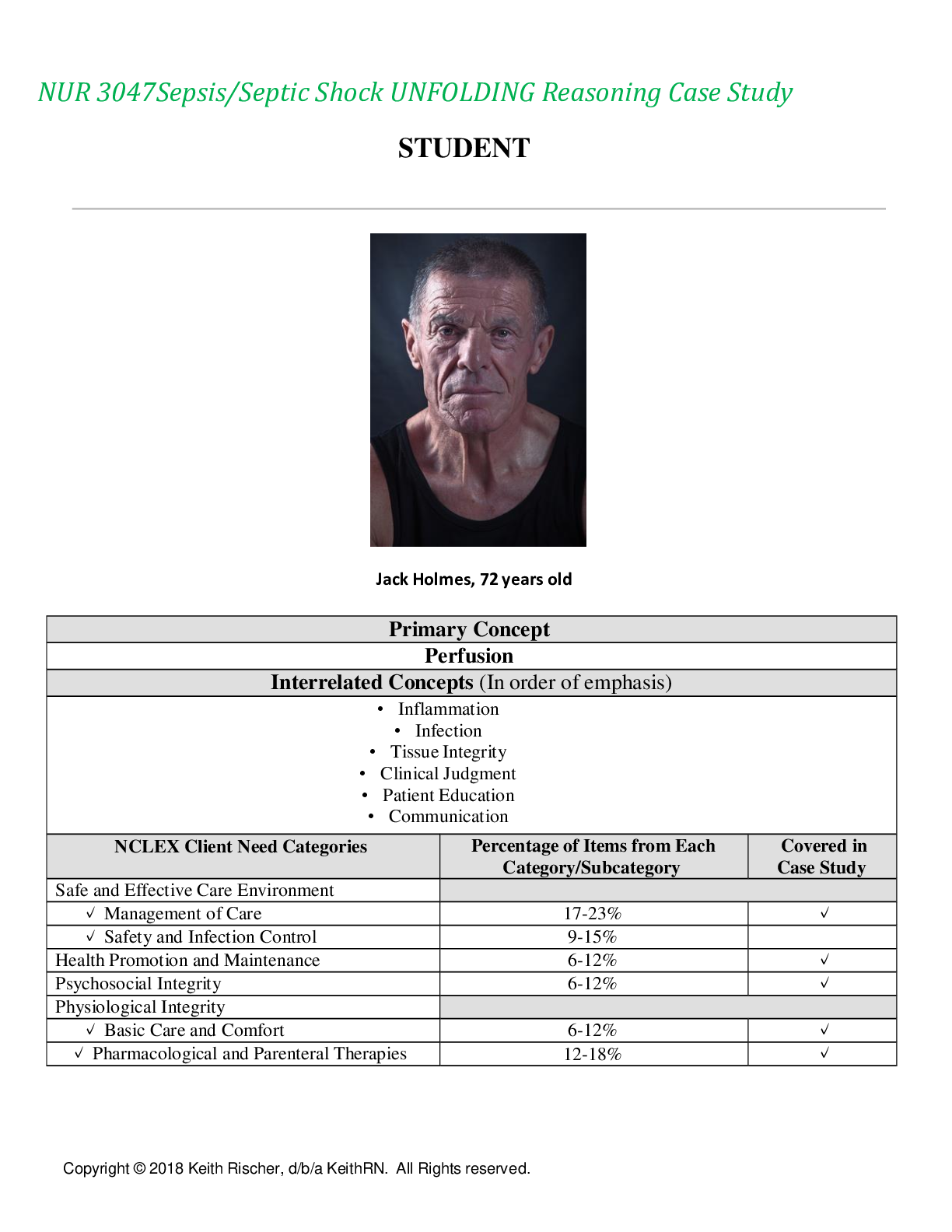
Reviews( 0 )
Document information
Connected school, study & course
About the document
Uploaded On
Sep 22, 2022
Number of pages
16
Written in
Additional information
This document has been written for:
Uploaded
Sep 22, 2022
Downloads
0
Views
57

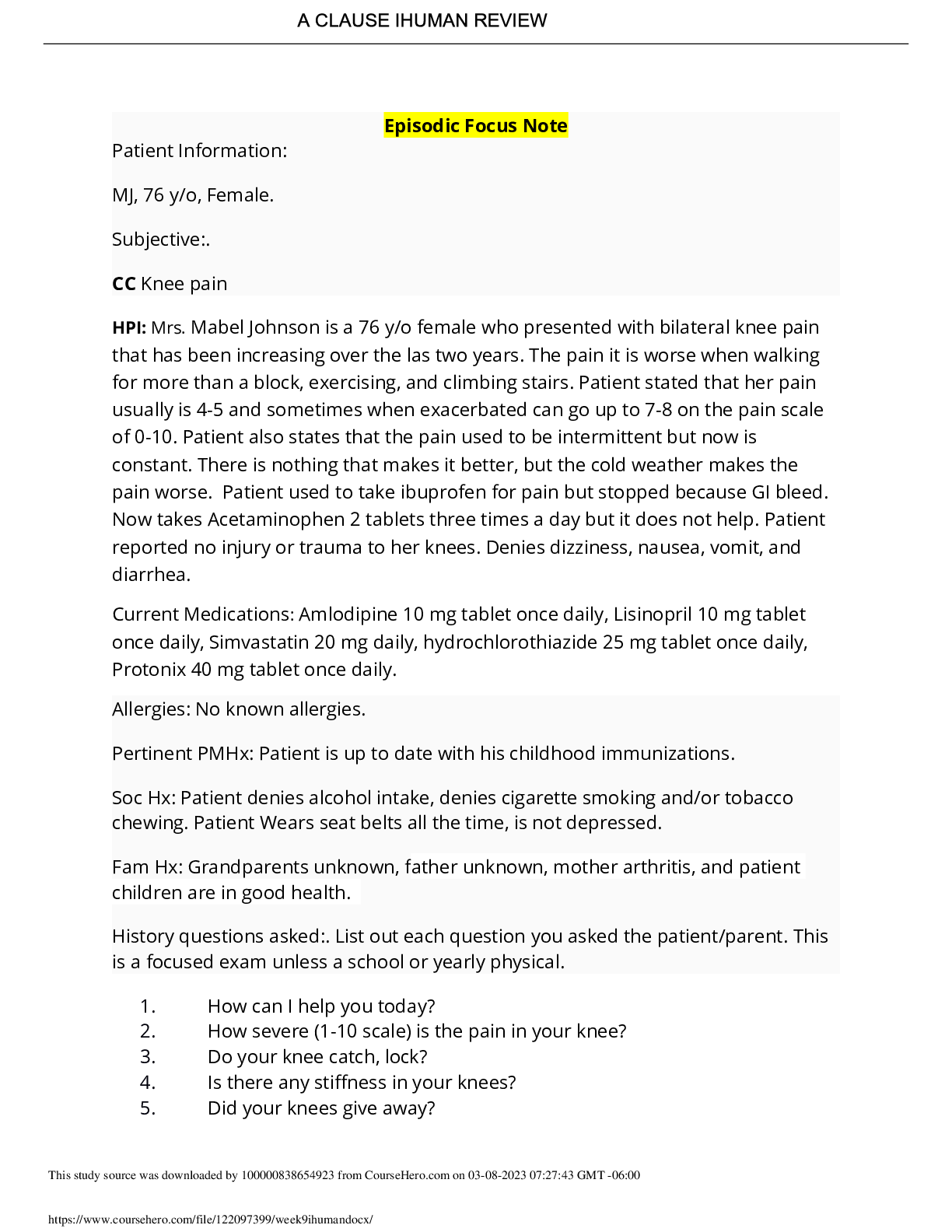
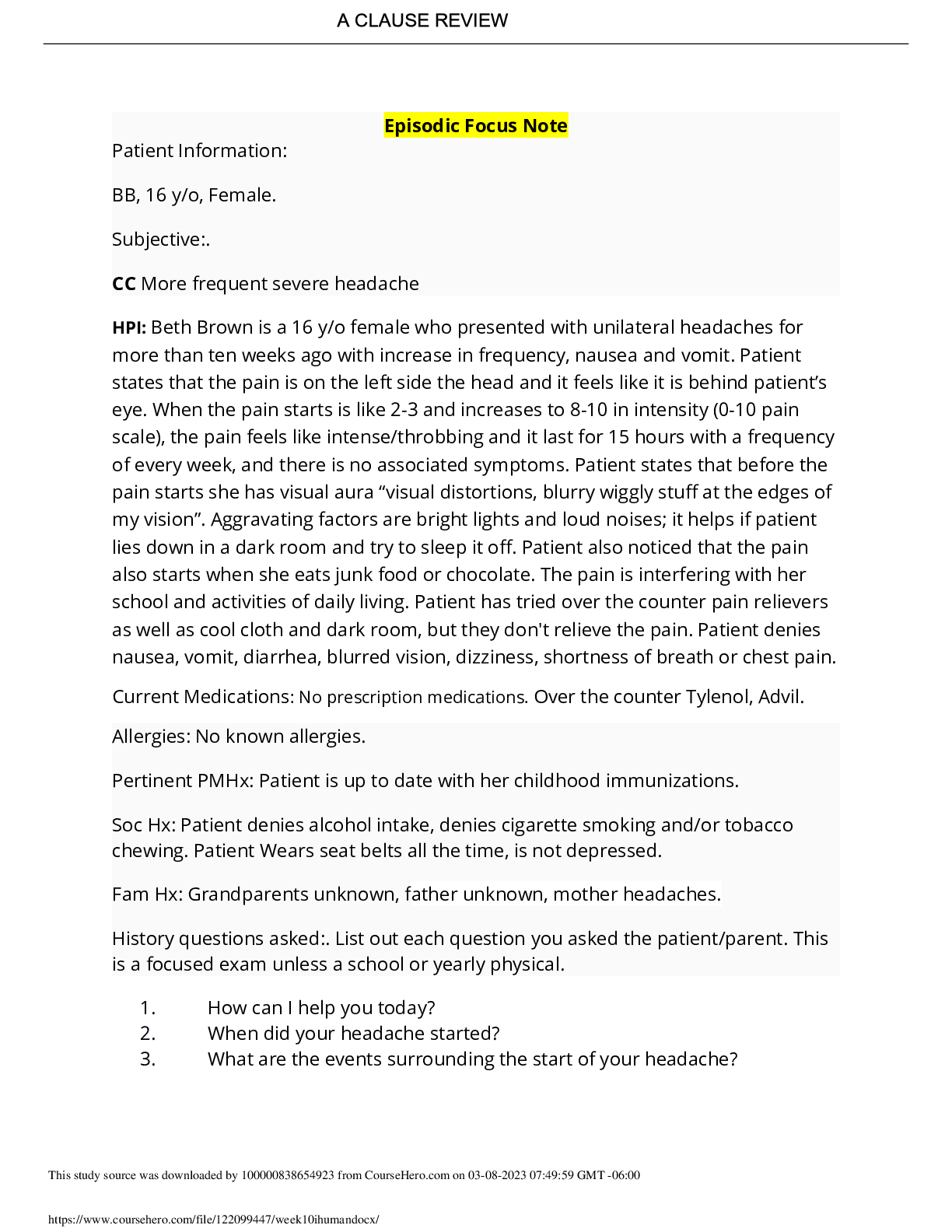


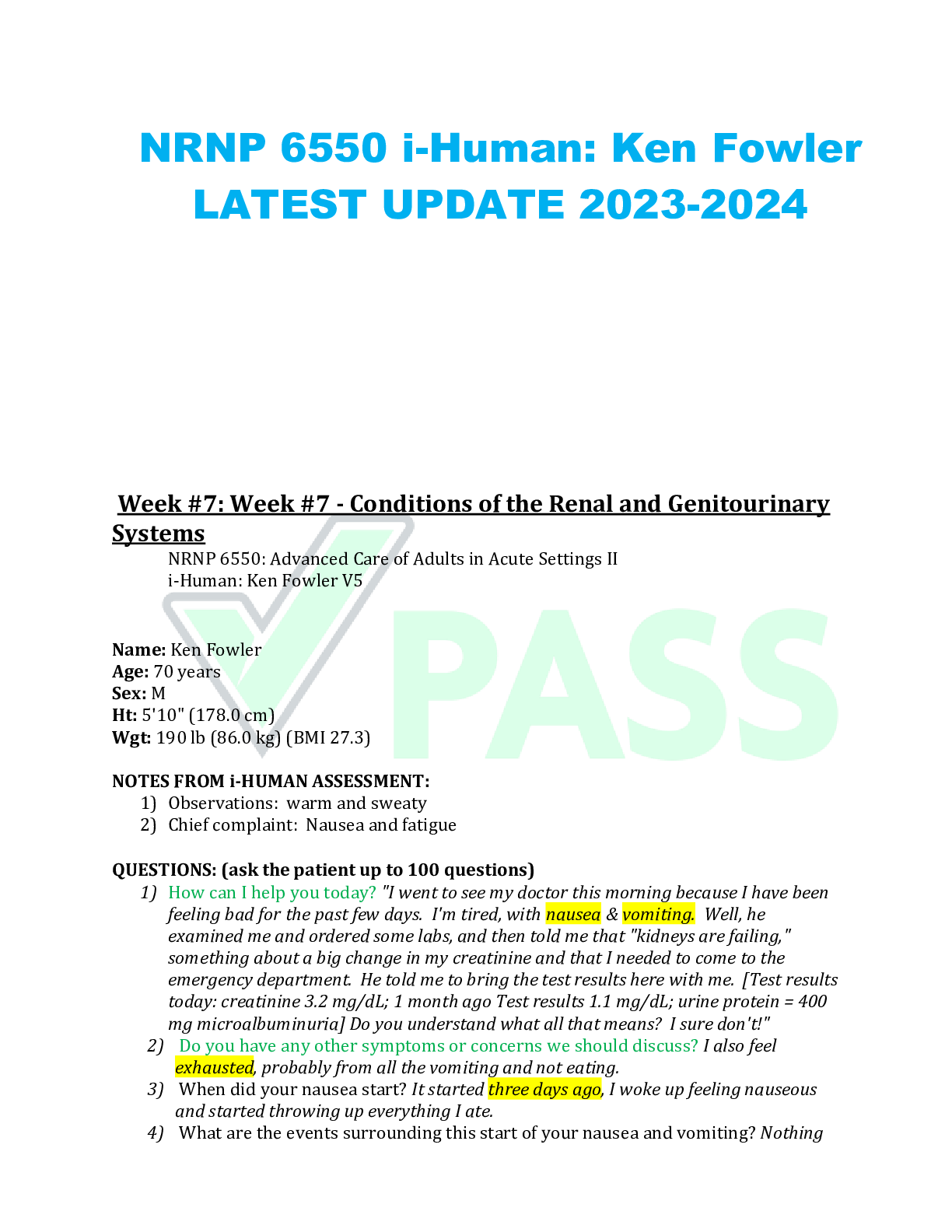
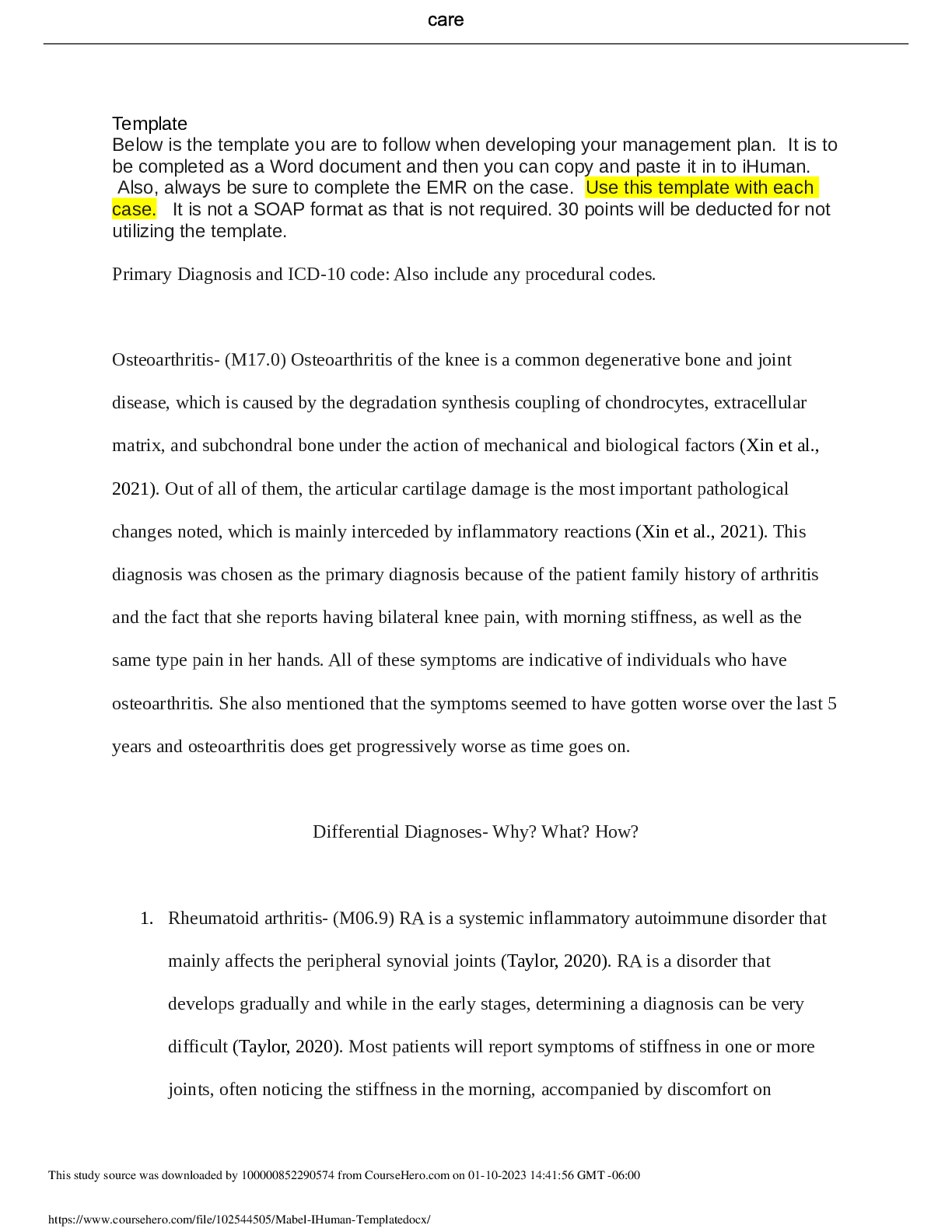



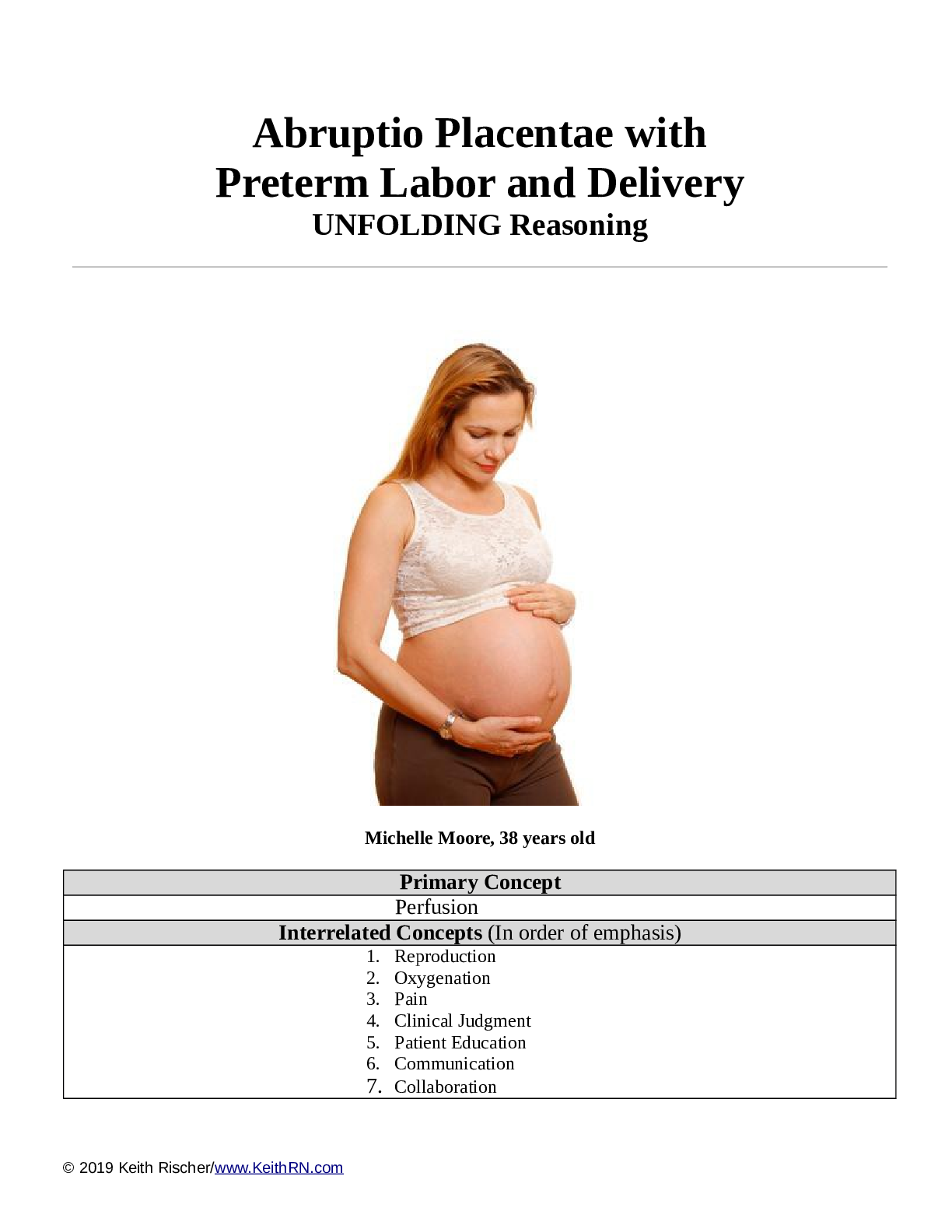
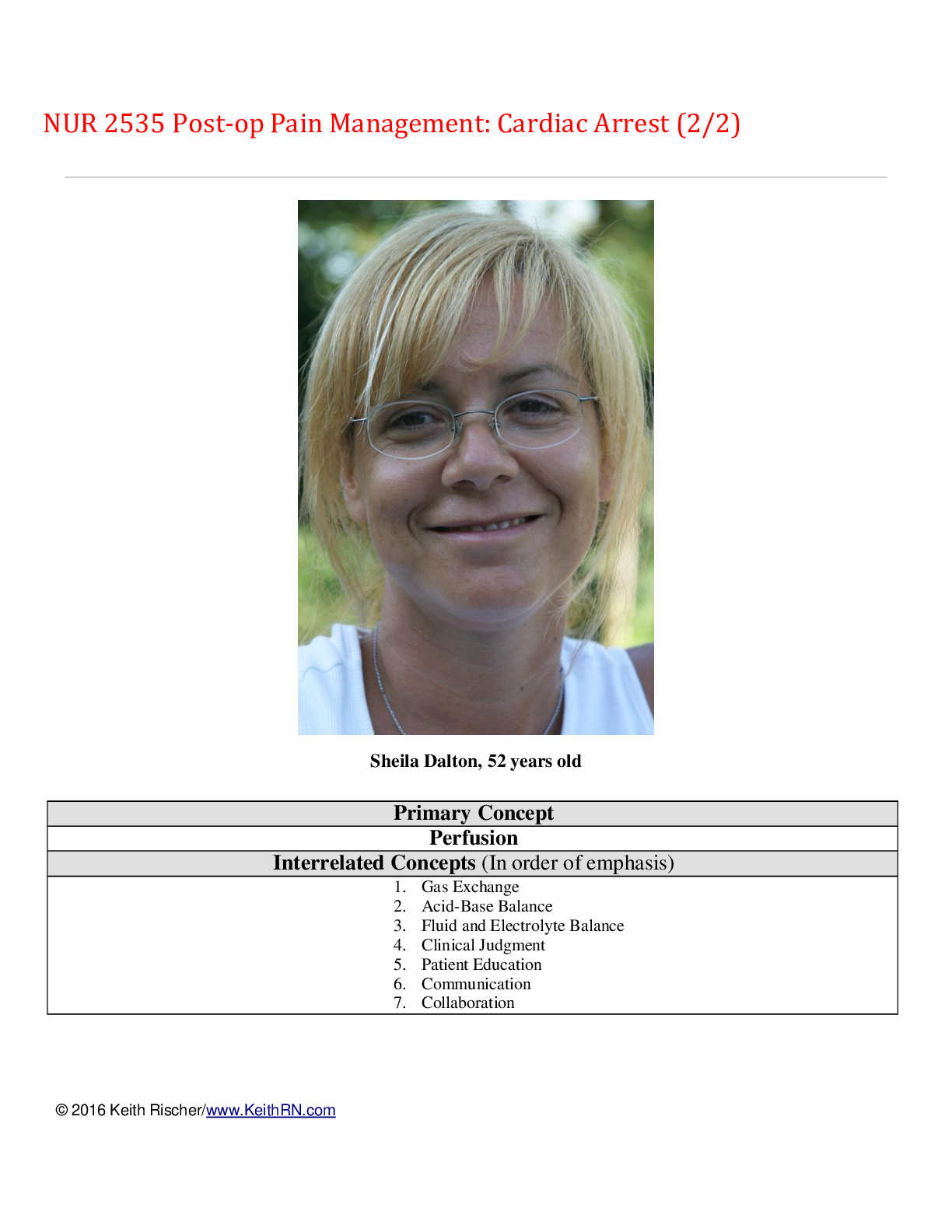

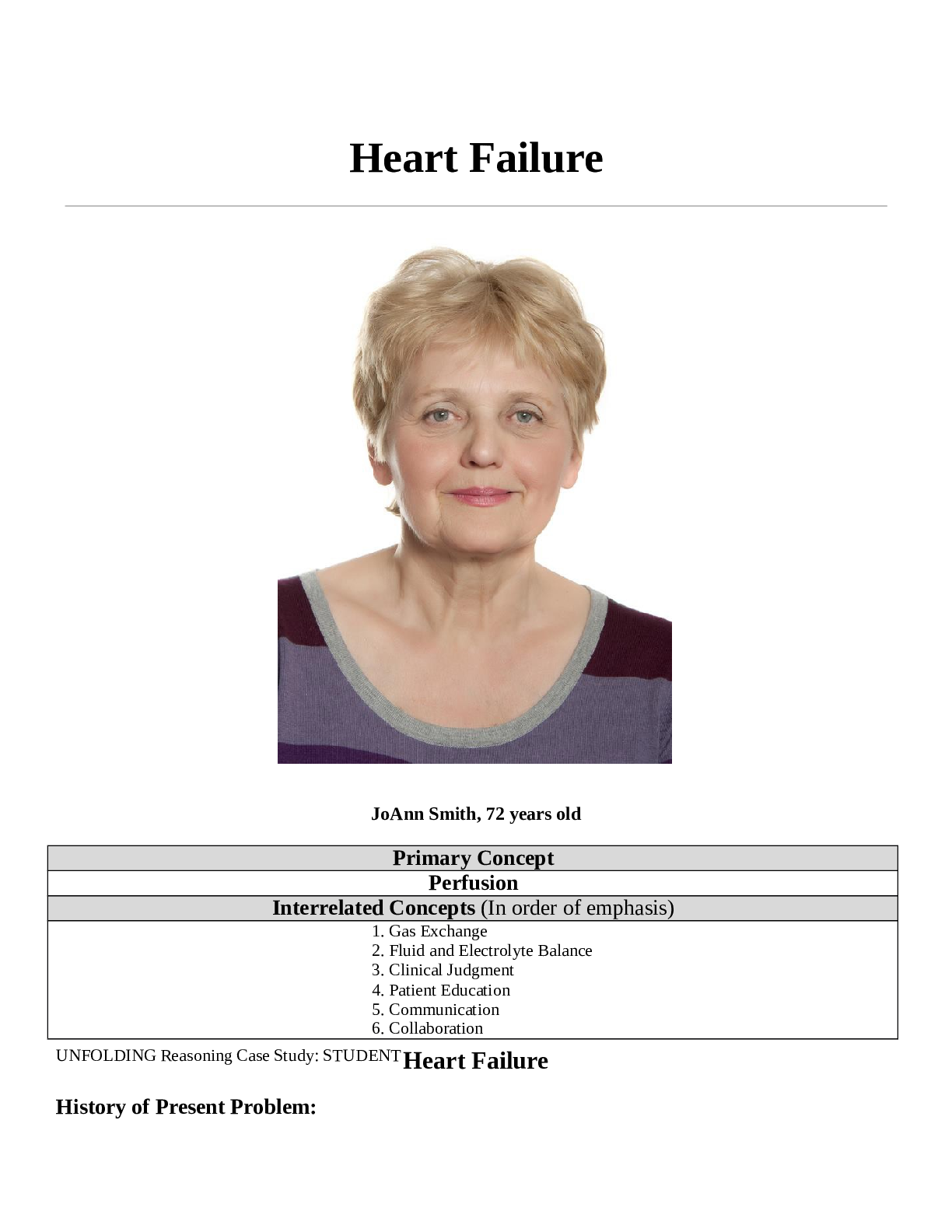
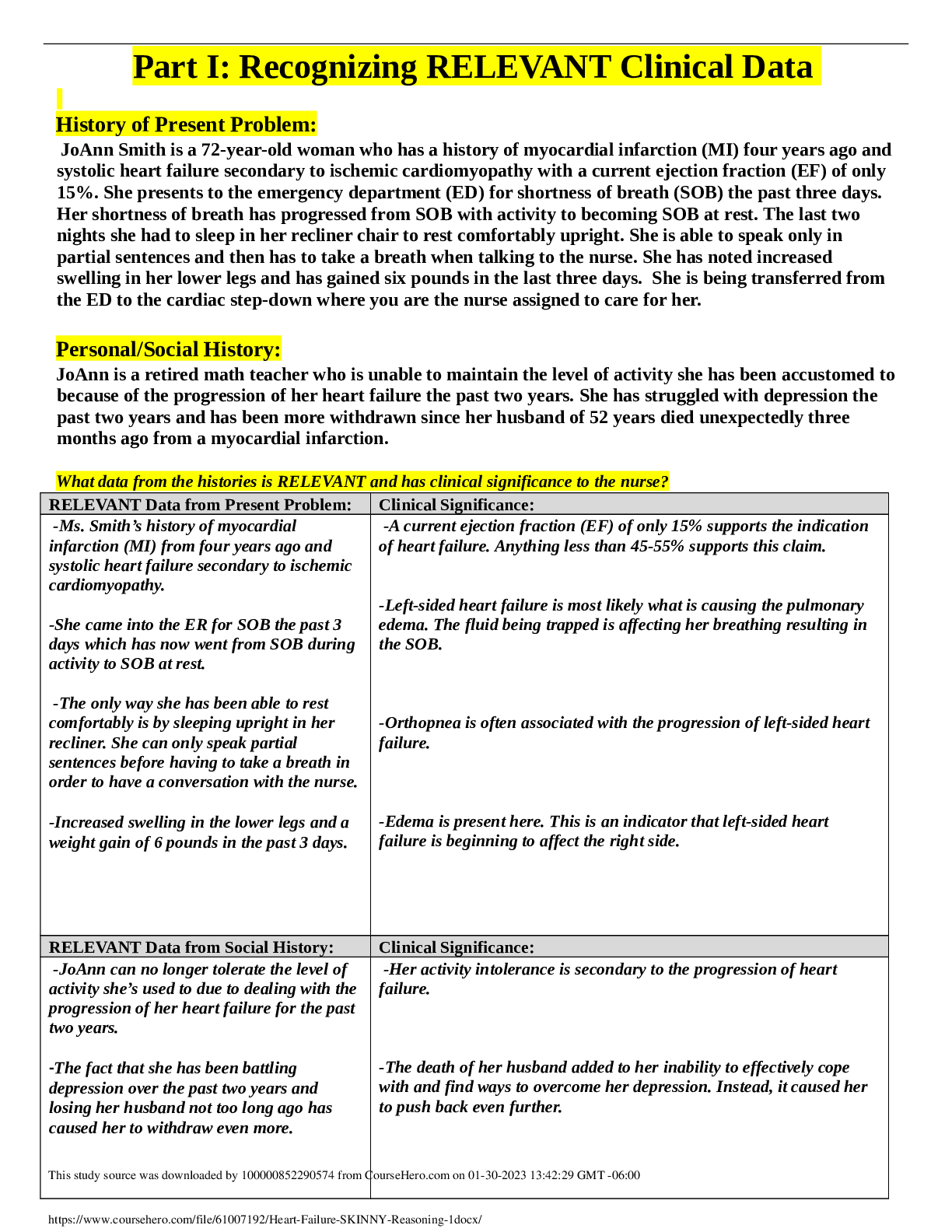


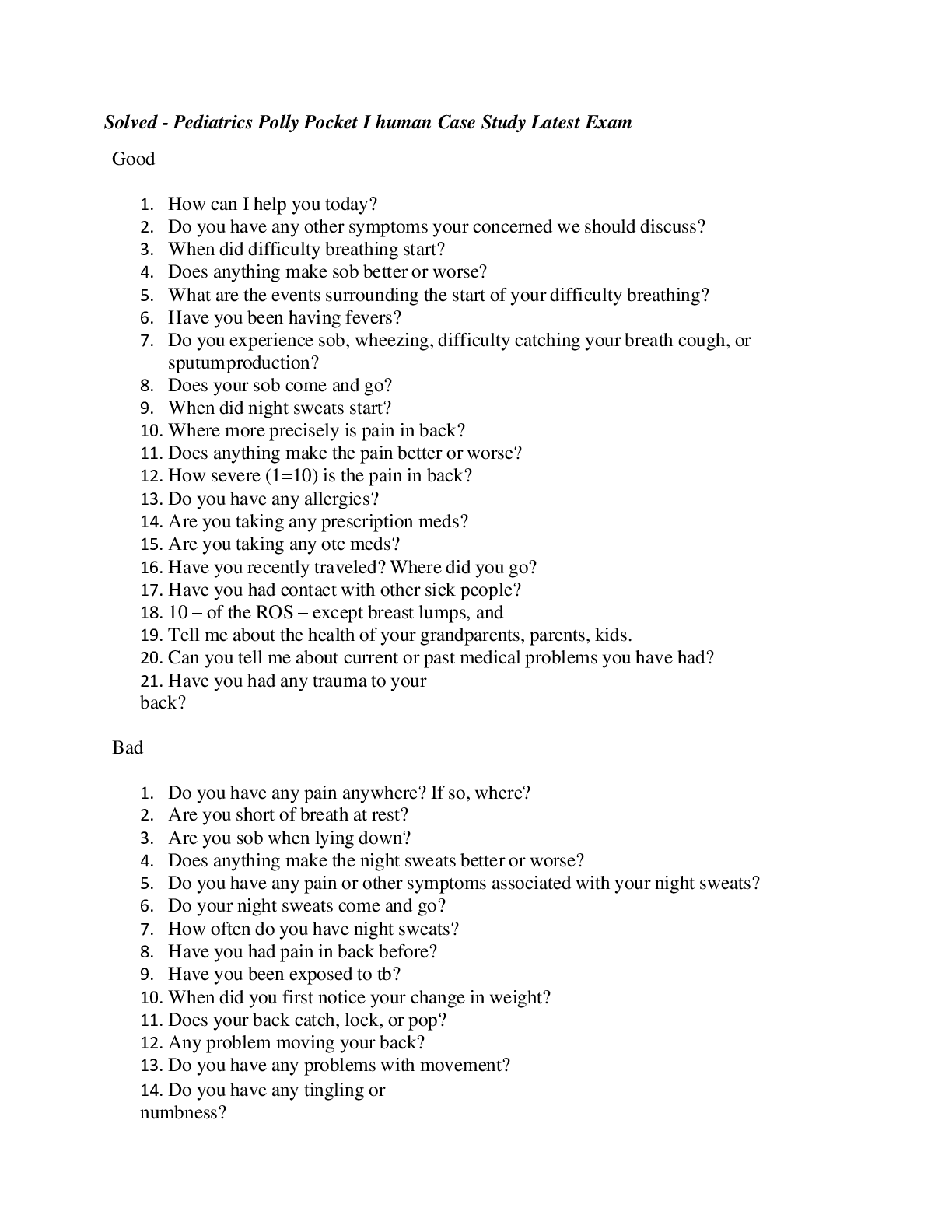


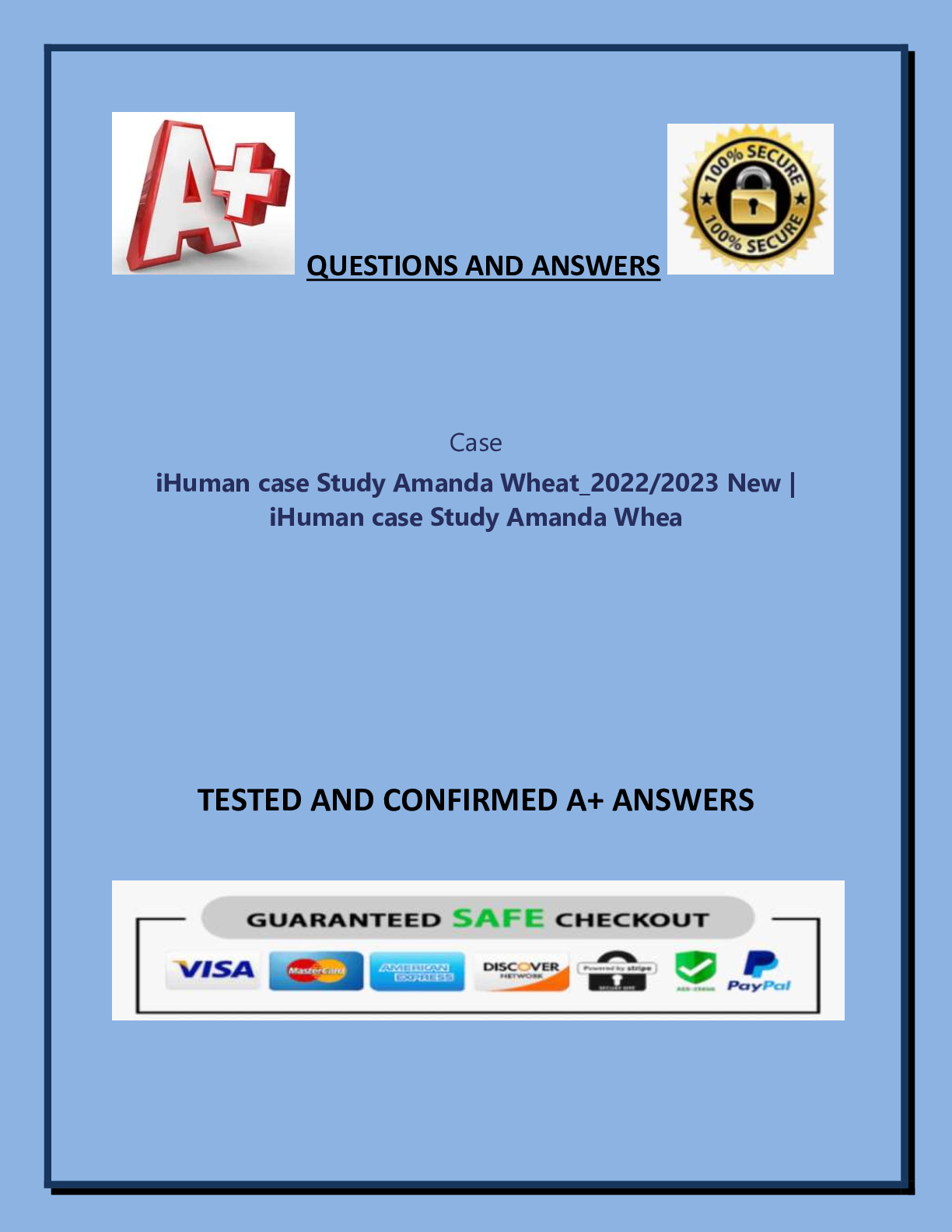
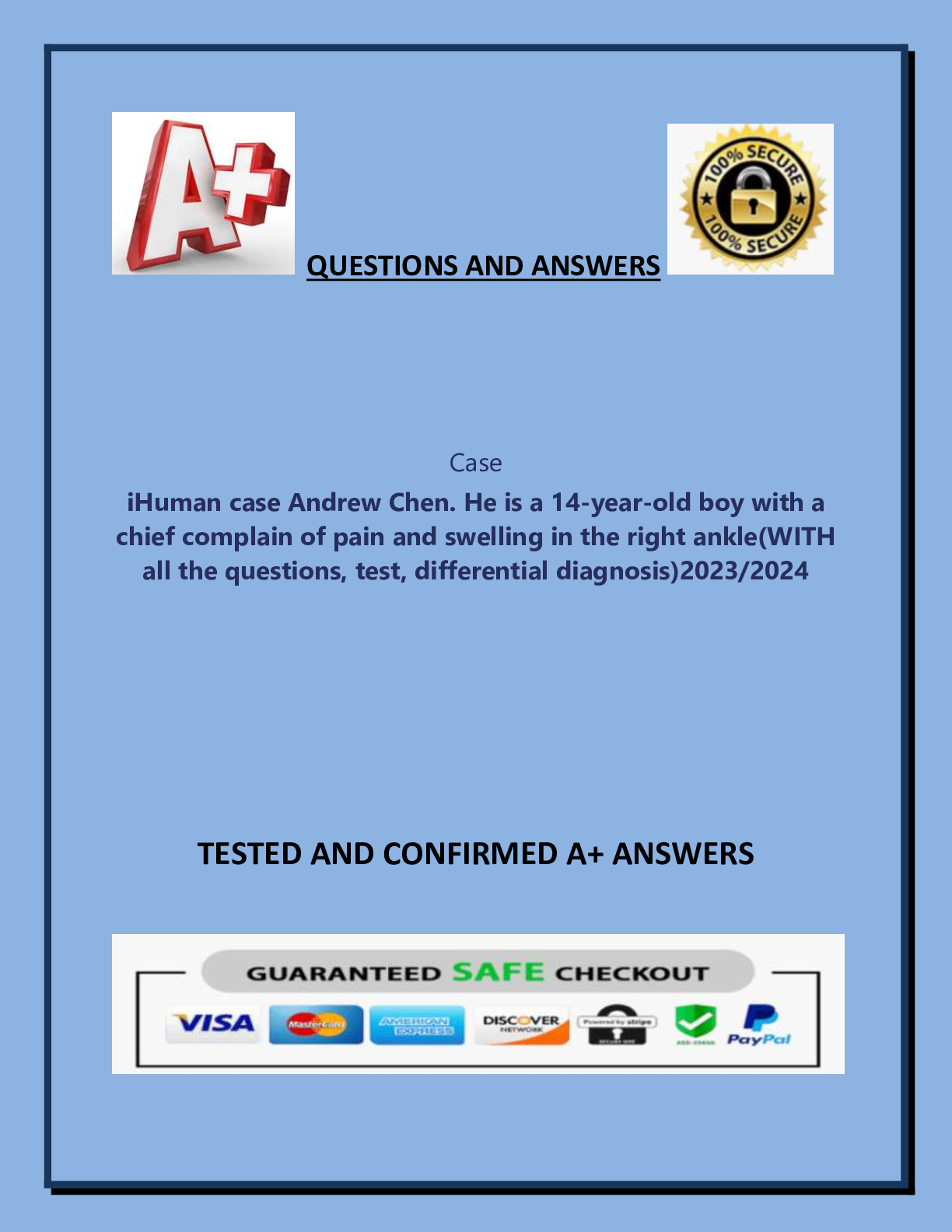
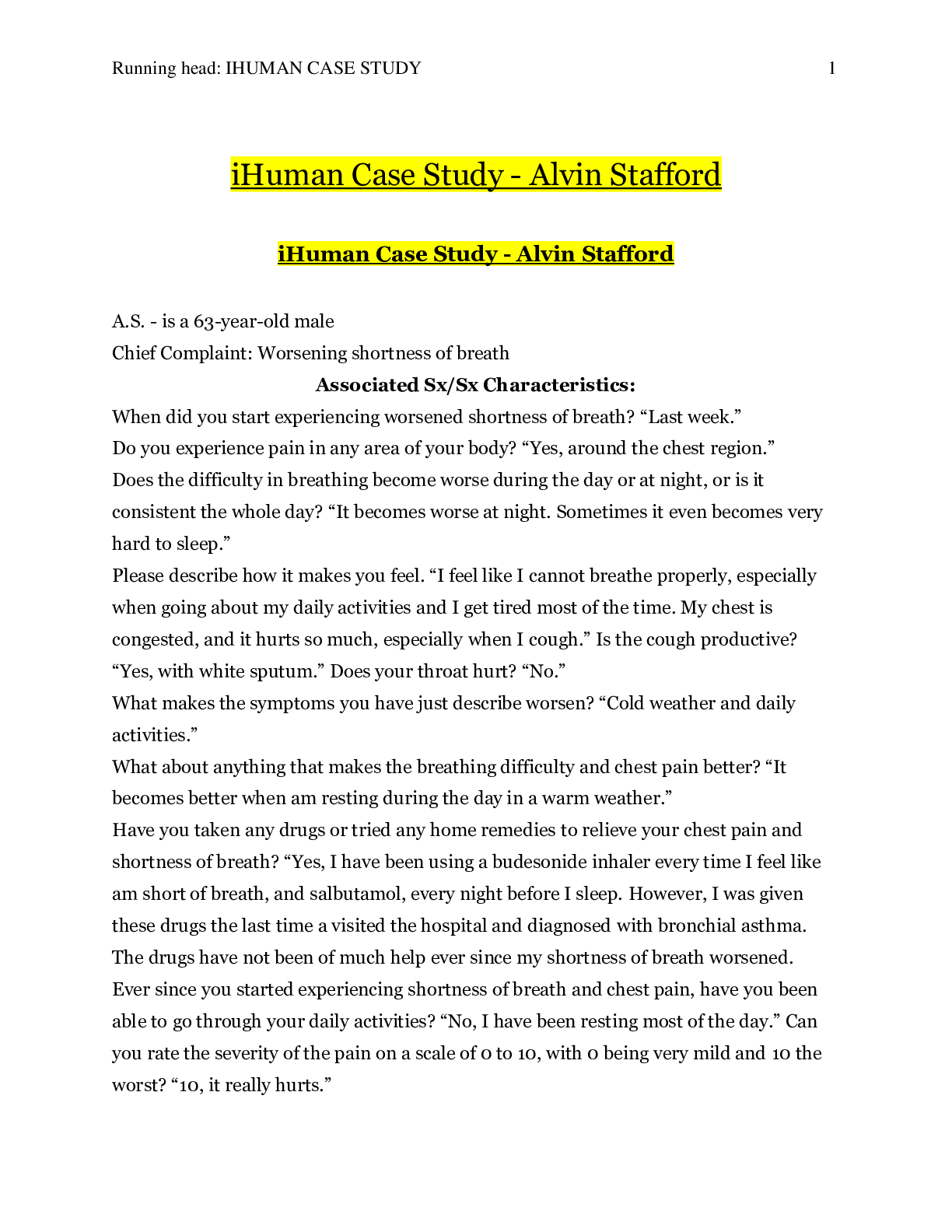
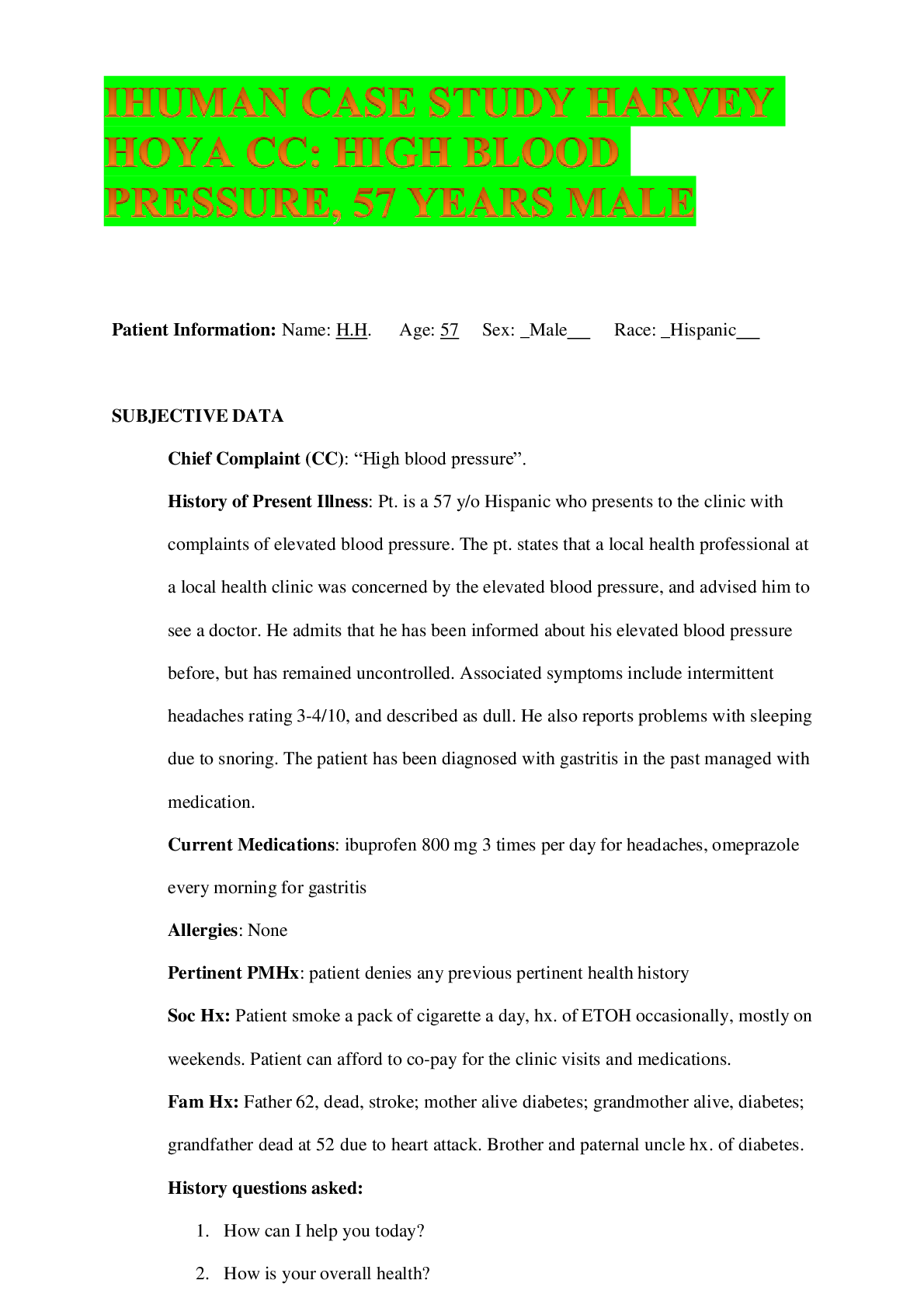
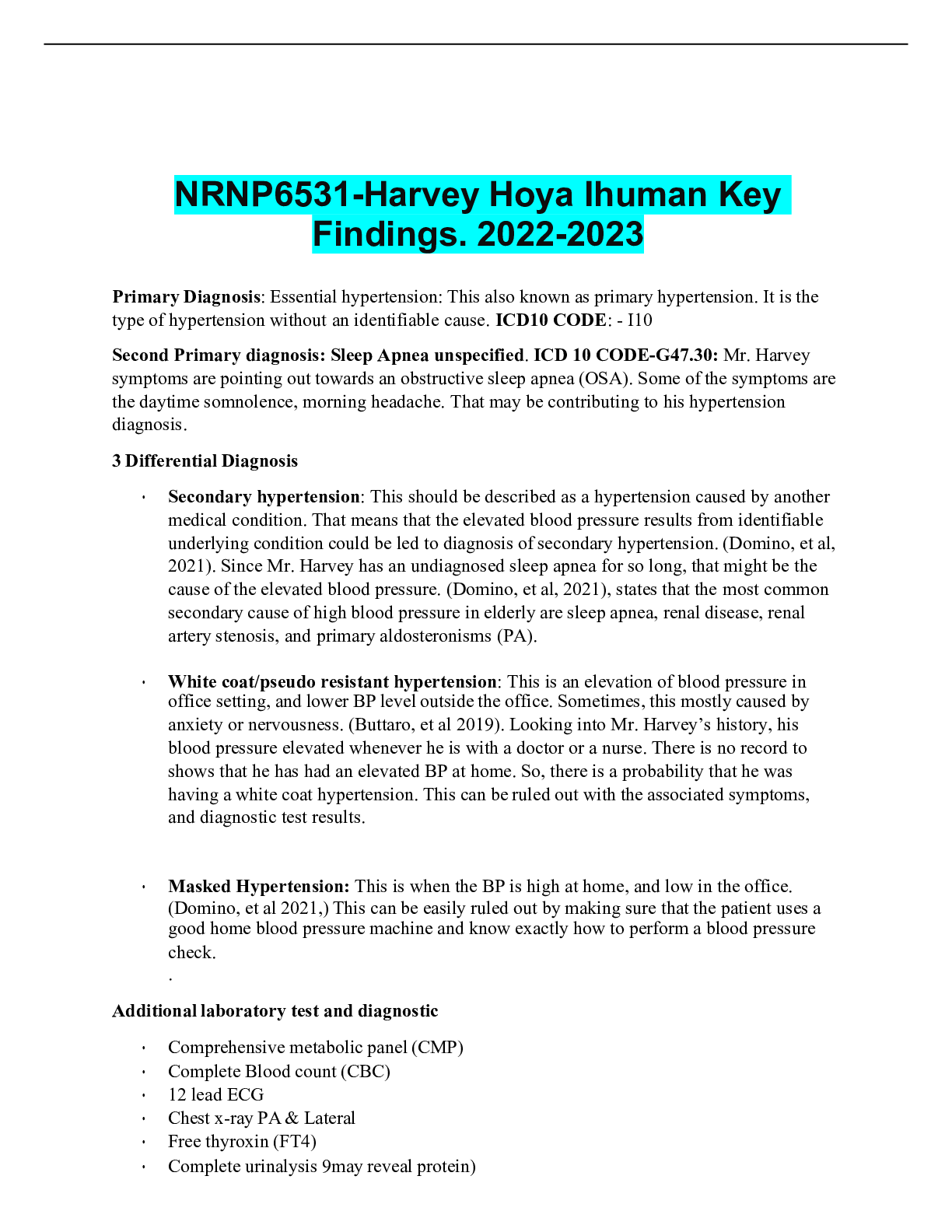
 2021.png)


